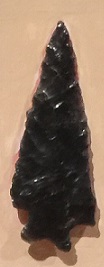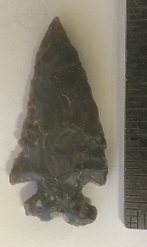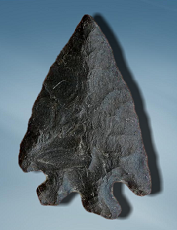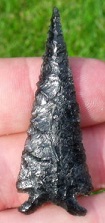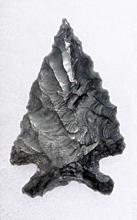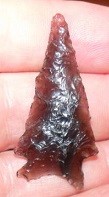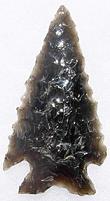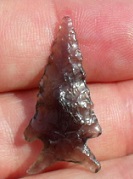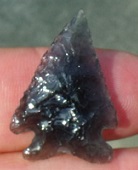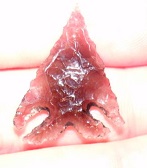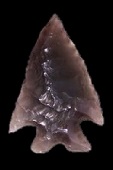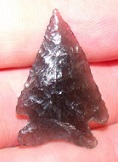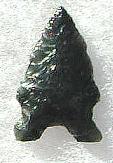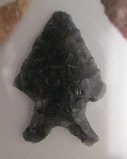Outline is Representative of Size and Shape:

Name Details:
Identified By: Robert F. Heizer and Martin A. Baumhoff
Named For: County Type Site is located
Date Identified: 1961
Type Site: South Fork Shelter, Elko County, Nevada
Identified By: Robert F. Heizer and Martin A. Baumhoff
Named For: County Type Site is located
Date Identified: 1961
Type Site: South Fork Shelter, Elko County, Nevada
Point Validity:
Valid type
Heizer was an eminent anthropologist and a professor at the University of California – Berkley. Heizer was influential in promoting our understanding of the archaeology of California and Nevada. Baumhoff was a distinguished anthropologist and serves as the Chair in the Department of Anthropology, University of California – Berkley. He conducted extensive studies into the archaeology of California. This type was named in a professional publication and has many professional references. This is considered a valid type.
Heizer was an eminent anthropologist and a professor at the University of California – Berkley. Heizer was influential in promoting our understanding of the archaeology of California and Nevada. Baumhoff was a distinguished anthropologist and serves as the Chair in the Department of Anthropology, University of California – Berkley. He conducted extensive studies into the archaeology of California. This type was named in a professional publication and has many professional references. This is considered a valid type.
Elko Eared
Cluster: Elko Corner Notch Cluster Description of Physical Characteristics and Flaking Pattern:
This is a small to medium triangular side notched point with a flattened to elliptical cross section. The blade may range from slightly excurvate to straight. Blades are commonly finely serrated. The shoulders may vary from horizontal to having a upward angle. The stem is expanding with a straight to slightly concave base. This point generally has a random flaking pattern, but may vary to a parallel oblique pattern.
Size Measurements:
Total Length - 24 to 68 mm (average 33 to 51 mm), Stem Length - 7 to 11 mm, Blade Width - 15 to 52 mm (average 18 to 24 mm), Neck Width - 11 to 32 mm (typically 13 to 17 mm), Basal Width - 13 to 42 mm (typically 10 to 20 mm narrower than the blade), Thickness 4 to 9 mm
Total Length - 24 to 68 mm (average 33 to 51 mm), Stem Length - 7 to 11 mm, Blade Width - 15 to 52 mm (average 18 to 24 mm), Neck Width - 11 to 32 mm (typically 13 to 17 mm), Basal Width - 13 to 42 mm (typically 10 to 20 mm narrower than the blade), Thickness 4 to 9 mm
Commonly Utilized Material:
Primarily obsidian followed by locally available materials including basalt
Primarily obsidian followed by locally available materials including basalt
Additional Comments:
It is thought that these points originated from the east and migrated west. These points were utilized for a great span of time starting in the Archaic phase and continuing into the Fremont culture. The older points were used as darts, the newer points may have been used as knives.
Elko Eared points appear earlier than the similar Elko Corner Notch points. They also peaked in usage before the peak of the Elko Corner Notch points. This pattern may also be seen at Shallow Shelter which had a concentration of Elko Eared points found in the same strata as Pinto points with Elko Corner Notch points having a higher concentration in the strata above the Elko Eared layer. However, other sites (Ex. Gatecliff Shelter) there are not temporal difference between the two points (Justice, 2002).
Elko Eared and Elko Corner Notch may represent a continuum of technology which may make distinguishing between the two types difficult. Both types may have a concaved base, but Thomas (1981) distinguished the two types based on the depth of the concaved base. He identified point with an indention ration of 0.93 or less as a Elko Corner Notch, and points with an indent ration greater than 0.93 as Elko Eared.
It is thought that these points originated from the east and migrated west. These points were utilized for a great span of time starting in the Archaic phase and continuing into the Fremont culture. The older points were used as darts, the newer points may have been used as knives.
Elko Eared points appear earlier than the similar Elko Corner Notch points. They also peaked in usage before the peak of the Elko Corner Notch points. This pattern may also be seen at Shallow Shelter which had a concentration of Elko Eared points found in the same strata as Pinto points with Elko Corner Notch points having a higher concentration in the strata above the Elko Eared layer. However, other sites (Ex. Gatecliff Shelter) there are not temporal difference between the two points (Justice, 2002).
Elko Eared and Elko Corner Notch may represent a continuum of technology which may make distinguishing between the two types difficult. Both types may have a concaved base, but Thomas (1981) distinguished the two types based on the depth of the concaved base. He identified point with an indention ration of 0.93 or less as a Elko Corner Notch, and points with an indent ration greater than 0.93 as Elko Eared.
Distribution: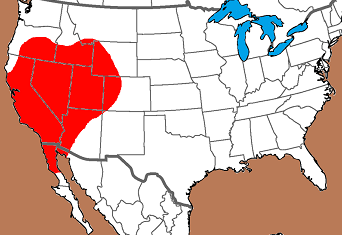

Distribution Comments:
This point is found through-out the Great Basin, into the Snake River Plain and into southeastern Oregon into the Klamath Valley. These points may be found into the northern Colorado Plateau. They are found westward into the Sacramento River Valley. These points are found southward into northern Baja California and northwestern Sonora Mexico.
This point is found through-out the Great Basin, into the Snake River Plain and into southeastern Oregon into the Klamath Valley. These points may be found into the northern Colorado Plateau. They are found westward into the Sacramento River Valley. These points are found southward into northern Baja California and northwestern Sonora Mexico.
Age / Periods:
Date: 3,500 - 1,400 B.P.
Cultural Period: Late to Transitional Archaic
Glacial Period: Neoglacial to Roman Warm
Culture:
Date: 3,500 - 1,400 B.P.
Cultural Period: Late to Transitional Archaic
Glacial Period: Neoglacial to Roman Warm
Culture:
Age Details:
Other points in this cluster / Related / Associated Points:
Amargosa, Elko Corner Notch, Elko Side Notch, Elko Split Stem
Amargosa, Elko Corner Notch, Elko Side Notch, Elko Split Stem



